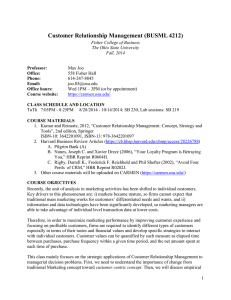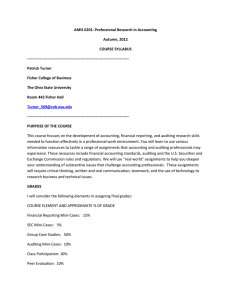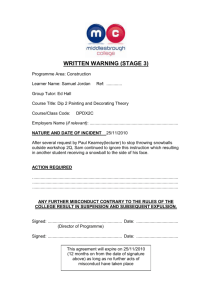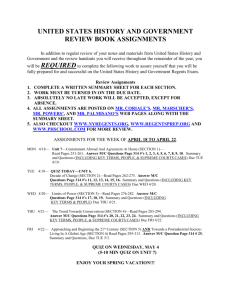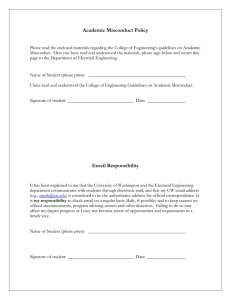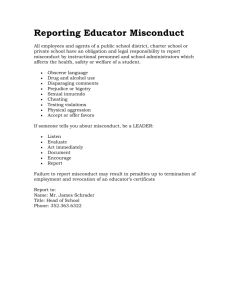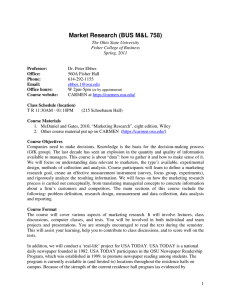Customer Relationship Management (BUSML 4212)
advertisement
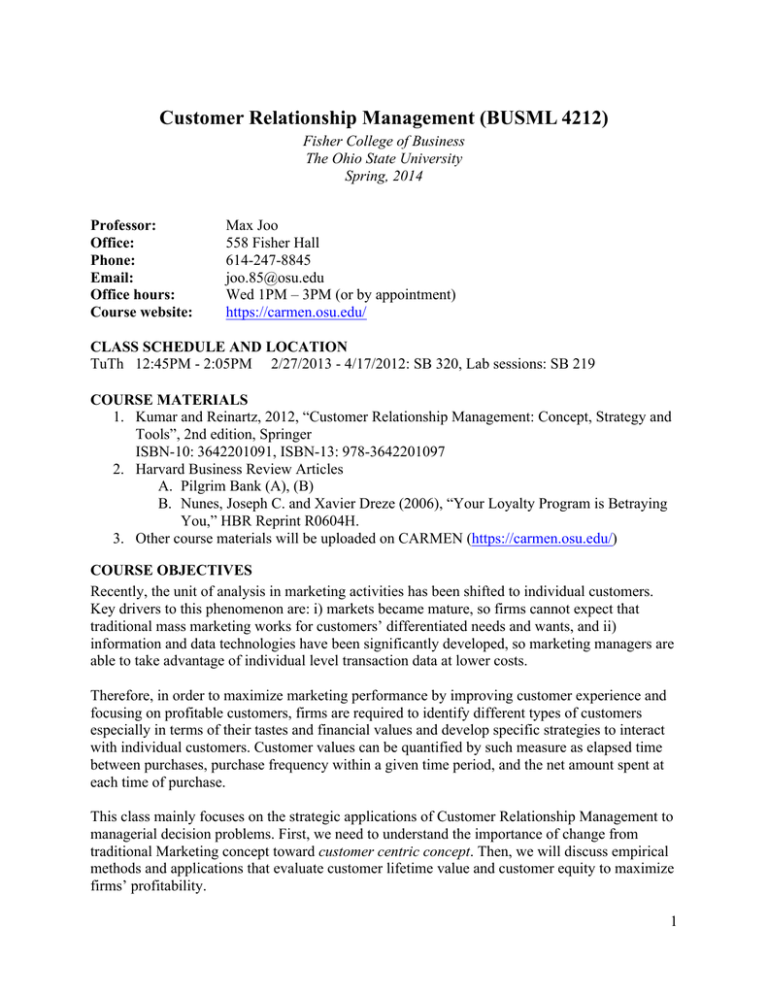
Customer Relationship Management (BUSML 4212) Fisher College of Business The Ohio State University Spring, 2014 Professor: Office: Phone: Email: Office hours: Course website: Max Joo 558 Fisher Hall 614-247-8845 joo.85@osu.edu Wed 1PM – 3PM (or by appointment) https://carmen.osu.edu/ CLASS SCHEDULE AND LOCATION TuTh 12:45PM - 2:05PM 2/27/2013 - 4/17/2012: SB 320, Lab sessions: SB 219 COURSE MATERIALS 1. Kumar and Reinartz, 2012, “Customer Relationship Management: Concept, Strategy and Tools”, 2nd edition, Springer ISBN-10: 3642201091, ISBN-13: 978-3642201097 2. Harvard Business Review Articles A. Pilgrim Bank (A), (B) B. Nunes, Joseph C. and Xavier Dreze (2006), “Your Loyalty Program is Betraying You,” HBR Reprint R0604H. 3. Other course materials will be uploaded on CARMEN (https://carmen.osu.edu/) COURSE OBJECTIVES Recently, the unit of analysis in marketing activities has been shifted to individual customers. Key drivers to this phenomenon are: i) markets became mature, so firms cannot expect that traditional mass marketing works for customers’ differentiated needs and wants, and ii) information and data technologies have been significantly developed, so marketing managers are able to take advantage of individual level transaction data at lower costs. Therefore, in order to maximize marketing performance by improving customer experience and focusing on profitable customers, firms are required to identify different types of customers especially in terms of their tastes and financial values and develop specific strategies to interact with individual customers. Customer values can be quantified by such measure as elapsed time between purchases, purchase frequency within a given time period, and the net amount spent at each time of purchase. This class mainly focuses on the strategic applications of Customer Relationship Management to managerial decision problems. First, we need to understand the importance of change from traditional Marketing concept toward customer centric concept. Then, we will discuss empirical methods and applications that evaluate customer lifetime value and customer equity to maximize firms’ profitability. 1 In modern marketing decision-making, customer orientation and consequent empirical methodology are critical, because they enable firms to achieve better per person ROI, acquisition and retention of profitable customers, and reactivation of dormant customers, which will eventually contribute to market performance of a firm. The main sections of this course include the following: customer-centric concept, customer lifetime value, customer equity and operational CRM. Having successfully passed this class, students should be capable of • explaining the need for customer centricity • understanding the role of CRM in managerial decision making • performing empirical analysis of customer values using SPSS and/or Excel • interpreting the results to apply to strategic decision making in real world problems • understanding the ways for firms to create and enhance the sources of customer values COURSE FORMAT The course will cover various aspects of customer relationship management. It will involve lectures, class discussions, computer classes, and tests. You will be involved in both individual and team assignments and projects. You are expected to read the designated chapter(s) in the textbook and HBR case(s) before attending class session. This will assist your learning, and help you contribute to class discussions and score well on the tests. COURSE REQUIREMENT AND GRADING Final grades consist of the following components: Final Exam Final Project – Pilgrim Case HBR Case Assignments Lab Assignments Class Participation In teams In pairs In pairs Includes attendance and in-class discussion 40% 20% 15% 15% 10% FINAL EXAM The final exam is designed to test students’ understanding of the conceptual and analytic material presented in class. There will be one exam in the week of final exams. Exams will include all contents from the textbook (indicated chapters only), classroom discussion, slides or other supplemental materials provided in class. These exams are multiple-choice questions. Basically, lectures and discussions in class complement, NOT substitute, reading the chapters and cases. Therefore contents in the textbook that are not explicitly discussed in class may be included in the exams. 2 FINAL TEAM ASSIGNMENT This project is a practice to the real world case. You are required to replicate the analysis in Pilgrim Bank case. Assume that you conduct a CRM project for a brand/firm. To achieve your goal, you need to first understand your problem and analyze and evaluate your customers. Therefore, you need to thoroughly understand and summarize the case, and present your own analysis given the customer data set. HBR CASE ASSIGNMENTS In addition to the final assignment, several case study materials will be assigned. They will be discussed in class, so you are required to summarize assigned case studies in one page before class. They are real world examples relevant to the corresponding textbook chapters. When you summarize the cases, you need to understand them first and critically think why they are important and how you can apply the knowledge to other cases. This will be 15% of your grade. Downloading guide will be distributed in class. CLASS PARTICIPATION AND LAB ASSIGNMENTS 10% of your grade is set aside for class participation. Regular attendance is expected and you will be tested on the material covered in class. Participation in discussion is encouraged. There will be a few lab assignments to hand in after lab sessions. Lab assignments will help you apply your knowledge to real data sets. This will be another 15% of your grade. OFFICE HOURS Your instructor is here to help you. Please do not hesitate to ask any questions. The best way to contact me outside class is via email. If you come to see me during my office hours, you do not have to make an appointment. If you need to see me at another time, please ask for an appointment via email. I might use Carmen to contact you. Please make sure that you receive emails sent by the Carmen system. You should also check your email frequently in case other group members or I need to contact you. BE A PROFESSIONAL IN CLASS A part of your grade will be determined by your contribution to class. Along with actively participating in class discussions, it will not hurt you to be “a professional” in class. For instance, come to class on time, do not engage in side conversations during class, and turn off cell phones or other communication devices. Inappropriate behavior, such as being rude or disruptive, may result in a lower grade for the class participation component. CLASS ABSENCE You are responsible for your own success. This means that it is your responsibility to attend, participate and absorb the materials. I count on your responsibility; therefore you may miss up to four classes for any reason (no need to present or even invent excuses). If you miss more than 4 times, there will be a proportional participation grade deduction – unless you can present 3 evidence of valid excuses (“my internet did not work” or “my computer did not work” are NOT valid excuses). As for the labs with assignment (marked LAB – Assignment), you have to attend if there is no valid excuse. TENTATIVE SCHEDULE Important dates are in bold. The schedule is subject to change. # Day Date Topic 1 Thu 27-Feb 2 Tue 4-Mar 3 Thu 6-Mar 4 5 Tue Thu 11-Mar 13-Mar 6 Tue 18-Mar 7 Thu 20-Mar 8 9 Tue Thu 25-Mar 27-Mar 10 Tue 1-Apr Welcome, course overview, introduction Opportunities in Practice: Customer Lifetime Value - to be presented by Mike McCaslin and Joshua Zhang (Nationwide, Customer Analytics Department) Conceptual Foundations of CRM Spring break (No class) Spring break (No class) Customer Centric Metrics, Acquisition, Retention Customer Equity 1 – RFM Analysis and Equity Lab 1 (SB 219) – RFM and Profitability Customer Equity 2 – Logistic Regression Lab 2 (SB 219) – Logistic Regression 11 Thu 3-Apr Pilgrim case (A) – Customer Profitability 12 Tue 8-Apr Pilgrim case (B) – Customer Retention Walk-in Consultation of Final Assignment 13 Thu 10-Apr 14 Tue Lab 3 (SB 219) – Sketch of Pilgrim case 15-Apr Loyalty Programs – Case Discussion 15 Thu 17-Apr Apr 24 (2~3:45PM) Operational CRM – Marketing Channels Final Exam Reading/Assignments Ch. 1 Ch. 2 Ch. 5 Ch. 6 Ch. 6 Due: Pilgrim Bank (A) Summary Ch. 5 Due: Pilgrim Bank (B) Summary Ch. 10 Due: Nunes and Dreze Summary Ch. 12 No Exceptions SPSS You can download the software on the OCIO Licensed Software Downloads website, at https://ocio.osu.edu/software. Windows and Mac OS X versions are available. 4 For additional information regarding this process and system requirements, you can visit the IT Service Desk (Phone: 614-688-4357 or Email: 8help@osu.edu). The IT service desks are located in 025 Central Classrooms and 60A Thompson Library. DROP Fisher College of Business strongly enforces University attendance policies. As per University rule 3335-8-33, any student may be disenrolled from a course for failure to attend by the first Friday of the term, or by the 3rd instructional day of the term, or by the second class meeting, whichever occurs first. http://trustees.osu.edu/rules/university-rules/rules8/ru8-33.html HONOR CODE Academic integrity is essential to maintaining an environment that fosters excellence in teaching, research, and other educational and scholarly activities. Thus, The Ohio State University and the Committee on Academic Misconduct (COAM) expect that all students have read and understand the University’s Code of Student Conduct and that all students will complete all academic and scholarly assignments with fairness and honesty. Students must recognize that failure to follow the rules and guidelines established in the University’s Code of Student Conduct and this syllabus may constitute “Academic Misconduct.” The Ohio State University’s Code of Student Conduct (Section 3335-23-04) defines academic misconduct as: “Any activity that tends to compromise the academic integrity of the University, or subvert the educational process.” Examples of academic misconduct include (but are not limited to) plagiarism, collusion (unauthorized collaboration), copying the work of another student, and possession of unauthorized materials during an examination. Ignorance of the University’s Code of Student Conduct is never considered an “excuse” for academic misconduct, so I recommend that you review the Code of Student Conduct, specifically, the sections dealing with academic misconduct. If I suspect that a student has committed academic misconduct in this course, I am obligated by University Rules to report my suspicions to the Committee on Academic Misconduct. If COAM determines that you have violated the University’s Code of Student Conduct (i.e., committed academic misconduct), the sanctions for the misconduct could include a failing grade in this course and suspension or dismissal from the University. In this course, it is also expected that each student will behave in a manner that is consistent with the Fisher Honor Statement, which reads as follows: “As a member of the Fisher College of Business Community, I am personally committed to the highest standards of behavior. Honesty and integrity are the foundations from which I will measure my actions. I will hold myself accountable to adhere to these standards. As a future leader in the community and business environment, I pledge to live by these principles and celebrate those who share these ideals.” If you have any questions about the above policy or what constitutes academic misconduct in this course, please contact me. 5 STUDENTS WITH DISABILITIES Any student who feels she/he may need an accommodation based on the impact of a disability should contact me privately to discuss specific needs. Please contact the Office for Disability Services at 614-292-3307 in room 150 Pomerene Hall to coordinate reasonable accommodations for students with documented disabilities. It is your responsibility to discuss this with me well in advance of an assignment due date or an exam. ADDITIONAL MATERIALS (not required, look at it based on interest) If you want to learn more about SPSS and multivariate data analysis, the following textbook provides an excellent and very easy-to-understand guide, which is also perfect for independent study. The book has proven to be a life-saver for students writing empirical theses in various disciplines. Field, “Discovering Statistics Using SPSS”, 3rd Edition, Sage Pub, 2009 6
